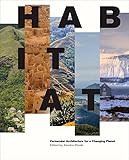Habitat : vernacular architecture for a changing planet / edited by Sandra Piesik.
Contributor(s): Piesik, Sandra [editor.]
Material type: TextDescription: 600 pages : illustrations (chiefly color), color maps ; 37 cmISBN: 9781419728808; 1419728806Other title: Vernacular architecture for a changing planetUniform titles: Habitat (Abrams (Publishing company)) Subject(s): Vernacular architecture -- Environmental aspects | Architecture and climate | Sustainable architecture | Climatic changes | Climatology | Sustainable architecture | Vernacular architecture -- Environmental aspectsDDC classification: 720/.47
TextDescription: 600 pages : illustrations (chiefly color), color maps ; 37 cmISBN: 9781419728808; 1419728806Other title: Vernacular architecture for a changing planetUniform titles: Habitat (Abrams (Publishing company)) Subject(s): Vernacular architecture -- Environmental aspects | Architecture and climate | Sustainable architecture | Climatic changes | Climatology | Sustainable architecture | Vernacular architecture -- Environmental aspectsDDC classification: 720/.47 | Item type | Current location | Call number | Status | Date due | Barcode |
|---|---|---|---|---|---|
 PG Books
PG Books
|
BMS College of Architecture | 720/.47 PIE (Browse shelf) | Available | AR-PG581 |
Browsing BMS College of Architecture Shelves Close shelf browser
"First published in the United Kingdom in 2017 by Thames & Hudson Ltd ... London"--Colophon.
Includes bibliographical references (pages 575-581) and index.
Foreword / Tomasz Chruszczow -- Introduction / Sandra Piesik -- The Influence of Climate on Building Design and Materials / Catherine Souch -- A Geological Classification of Earth Materials in Vernacular Construction / Graham Lott -- Plants in the Built Environment / William Miliken -- An Anthropological Introduction to Vernacular Architecture André Singer -- The Value of the Vernacular / Jim Coleman Henry Fletcher -- Tropical -- Dry -- Temperature -- Continental -- Polar -- Appendix 1: Contemporary Vernacular -- Appendix 2: Natural Disasters -- Appendix 3: Materials Science.
Materials Science."Vernacular architecture is architecture without architects; designed based on local needs, these buildings make use of natural resources and demonstrate diverse architectural forms, design elements unique to their culture, and ingenious construction techniques. From bamboo garden pavilions in China to homes made from reeds in southern Iraq, and mud dwellings in Mali to pine huts in Siberia, Habitat showcases the diverse and indigenous materials that can be used to build innovative, sustainable structures. The core of Habitat is arranged by climate zone, from desert to tropical, temperate to arctic. Within each section, buildings are presented regionally, showing how local climatic conditions and vegetation affect the evolution of building styles. Complete with a range of essays exploring the economic and anthropological aspects, as well as a reference section with information on materials science and engineering, Habitat offers real-world insights into sustainable buildings and stresses the importance of preserving disappearing craftsmanship and local knowledge."--








There are no comments for this item.